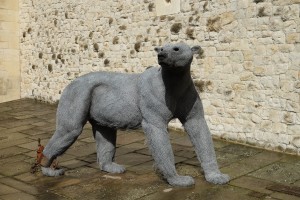We are up at 7am and to the underground by 10. Today we visit the Tower of London. It’s a little rainy so we take our rain gear.
Once inside the walls we head lickity-split to the Crown Jewels, a popular tour. The tour starts with some very interesting videos (some are animated) showing the the many kings and queens who have worn the crown from William the Conqueror (1066) to the current monarch, Queen Elizabeth II (crowned in 1953). There is a video of Queen Elizabeth’s coronation–as Howard as an eleven year-old boy watched the coronation on TV, he fell madly in love with her, he says. Next you view all of the coronation items: ceremonial maces, swords and trumpets. Then comes the display of royal regalia: an eagle-beaked flask from which the anointing oil is poured, the Sword of Offering and the 20-pound gold robe. Finally you enter the room with various crowns, orbs and scepters. In these precious items are contained the 530-carat Star of Africa diamond, the 106-carat Koh-I-Noor diamond and a large blue sapphire from Edward the Confessor’s coronation ring. Of course there are also thousands of diamonds, pearls and semi-precious stones. Wow! But I have to say after seeing all those priceless symbols of the monarchy, I can see why some people believe it’s time for the monarchy to end. Kind of like the Vatican. How are all that gold and those priceless jewels helping the world? And how COULD it help the world today?
So speaking of the monarchy we head out to see the towers in which they were imprisoned and the places they were beheaded. We visit Beauchamp Tower where “Very Important Prisoners” were held. The walls are covered with graffiti expressing the prisoners’ hopelessness of ever leaving the tower and their final and last words.
The White Tower houses an interesting exhibit of suits of armor displayed on human and horse manikins, weaponry, instruments of torture and the execution ax and chopping block for…you know…
For 600 years beginning in the early 1200s, exotic animals were received at the tower as royal gifts and the animals were kept at the Royal Menagerie for the entertainment and curiosity of the court. The first royal beasts to arrive at the Tower – the lions, polar bear and elephant – came from Europe and North Africa. In later years, the variety of animals at the Tower increased. Everything from elephants to tigers, kangaroos and ostriches lived in what was known as the Royal Menagerie. Responding to this tradition, Artist Kendra Haste has recreated some of the most popular animals as wire-mesh animal structure pieces for an exhibition called Royal Beast. Haste’s life size polar bear gives visitors an idea what it would have been like hundreds of years ago. Seeing the bear, poised and chained brings an overwhelming sense of disbelief that an Arctic animal made it to London during the 1300s.
The only animal to have survived until today are the tower’s ravens. According to tradition, the Tower and the British Throne are only safe as long as ravens are present. “The ravens are now treated almost like royalty. Like the Royals, the ravens live in a palace and are waited on by servants. They are kept at public expense, but in return they must show themselves to the public in settings of great splendor. So long as they abide by certain basic rules, neither Royals nor ravens have to do anything extraordinary. If the power in question is political and diplomatic, the Royals now have hardly more than the ravens. But the word “power” here can also mean the aura of glamour and mystery which at times envelops both ravens and monarchs.” (Boria Sax, author of books on human-animal relations) HA!
We have a delicious lunch at the Tower’s restaurant. I have a tasty plate of ham, potatoes and beans and Howard has sausage and mashed potatoes.
We decide to take the boat “bus” back to Westminster and then take the tube home.
